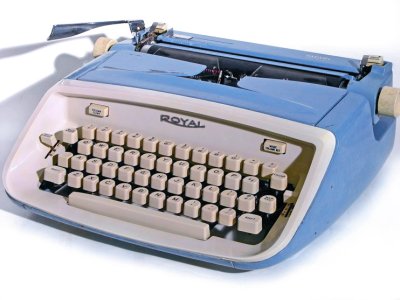Seeing this piece reminded me of the Royal Safari manual typewriter my Grandaddy bought for me. In the beginning its purpose was to type up the specs for various jobs he would be presenting to clients. Since there wasn't a printer or copy machine in the home, carbon paper was used to make a number of copies at one time.
Carbon paper (originally carbonic paper) is paper coated on one side with a layer of a loosely bound dry ink or pigmented coating, usually bound with wax. It is used for making one or more copies simultaneous with the creation of an original document. (wikipedia)
The problem with carbon paper was that it could be messy staining the fingertips with black ink.
The way it worked was:
Carbon paper is placed between the original and a the second sheet to be copied onto. As the user writes or types on the original, the pressure from the pen or typeface deposits the ink on the blank sheet, thus creating a "carbon copy" of the original document. This technique is generally limited to four or five copies.
As the ink is transferred from the carbon paper to the underlying paper, an impression of the corresponding text is left on the "carbon" where the ink was removed. A single piece of carbon paper can be repeatedly reused until the impression grows too light. (wikipedia)
After Grandaddy retired I took the typewriter off to college with me. It would be needed to type the numerous papers assigned. I was even able to make a little money by typing papers for people. Most typists charged by the page. Though I wouldn't conform to the correct way of typing, I was pretty fast for a hunt-and-peck. It's the same as what I do now.
 |
| Royal Safari model typewriter in case Copied from philsretro.com |
 |
| This typewriter is a twin to the Safari I have.Copied from machinesoflovinggrace.com |
This is my Royal Safari. Notice the red dot ? I had given it away for a church bazaar. The asking price was $5.00. So, you may be asking, why do I still have it? After the bazaar, those items that didn't sell were stored in the rectory. Summer before last, the rectory was being transformed into a Community Resource Center. All of the junk and unnecessaries would need to be removed. I was part of the clean up committee. While purging I came across my old Safari. Since it hadn't sold and had been sitting there among other non sells for about three years, I took it home. The handle came off long ago so it had to be carried in the arms like the vintage baby it is.
BTW I used Piknik's Ortonish effect for the photos below
The dented impression you see to the left came from storing it close to a gas heater where it became too warm.
You may find this hard to believe but when I got ready to open it, it was locked. Would I be able to get it open without a key? After close to 40 years where
would I find a key? Look a little closer to the right of the ribbon cover
( I looked that up because I didn't know what it was called LOL) and you will see two keys which I found living inside the jewelry box I have had since I graduated from high school (but that's another story)
I twisted them around in the key hole and Voila! open Sesame!
Though the typewriter went through some rough times, it still works. I took it to school once and the 5th graders had never seen one before. They were fascinated by it. The first thing they asked was, "How do you turn it on?" I explained to them that it was a manual typewriter and what the word manual meant. Each one was allowed to type their name in either red or black since there was a choice of two colors. (Ooohs and aaahs)
Just My Type is a book about various fonts and how they came to be. I'd heard a review of the book on public radio and place my name on the reserve list at the library so that I could view it.
 It tells of the most popular and least popular fonts as well as those that have become extinct. There were rivalries among printsetters and stealing of others fonts tweaking them just enough to make them their own.
It tells of the most popular and least popular fonts as well as those that have become extinct. There were rivalries among printsetters and stealing of others fonts tweaking them just enough to make them their own.
Who knew type design could be so brutal?
Though there isn't much difference in the fonts for Blogger I'll tell you a little about two of the ones I've used in the sentence above.
Arial- considered a cheat. It was designed in the early 1980's as an alternative to Helvetica
Courier- said to be similar to the old fashioned typewriter fonts. Some users feel that it is too crowded making reading difficult. Also known as American Typewriter and Toxica
My personal favorite is Times Roman
That's It ***




No comments:
Post a Comment